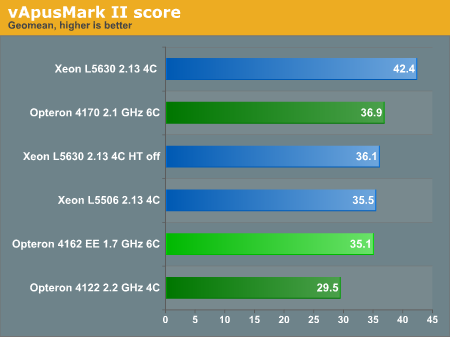Balancing Power, Price, and Performance in the Server CPU World
by Johan De Gelas on March 3, 2011 7:07 PM EST- Posted in
- IT Computing
- AMD
- Intel
- 1000W
- Xeon
- Opteron
- Cloud Computing
Virtual Performance on vSphere 4
Performance might not be the top priority when you buy these types of servers, but it is still important. The Tyan server can have up 96GB of RAM, so you don't want the CPU to become a bottleneck when you are consolidating your workloads. You also want quite a bit of future headroom in case you like postponing the capital investment in new servers.
So we turned to our vApusMark II, which runs eight virtual machines. Each virtual machine contains a real-world application, not just benchmarks. You can find a detailed description of how vApusMark II is set up and configured here.

Interestingly, the L5630 wins with a 17% margin thanks to Hyper-Threading. The Opteron 4170 HE holds its own pretty well considering it is three times cheaper. However, it is important to understand that the lower the price of the CPU, the less impact it will have in the overall capital investment in the servers.










35 Comments
View All Comments
mino - Thursday, March 3, 2011 - link
While the Wh metric is useful for efficiency evaluation, it is pretty much useless for the exact scenario you mention in the conclusion - power-capped server hosting.Please add the load-power numbers to the article.
ppokorny - Sunday, March 6, 2011 - link
And if lower results are better, shouldn't the graphs be sorted so the shorter bars are on top?mfenn - Thursday, March 3, 2011 - link
People actually use the bezels on Dell servers?JohanAnandtech - Saturday, March 5, 2011 - link
Only for pretty pictures :-)Lord 666 - Thursday, March 3, 2011 - link
Trying to hold off on the 5600 purchase hoping that the 5700s are almost here.Any idea?
duploxxx - Friday, March 4, 2011 - link
ready to hold off until september - oktober?I assume you select an Intel server cpu by default as usual by IT?
Ben - Thursday, March 3, 2011 - link
I know that noise level is a bit of a joke for a "real" server, but I've had customers ask me about installing servers in environments that are less than ideal, where the noise level would be a factor in their decision (such as the corner of an office that is occupied).I would be interested in seeing noise levels from these units and possibly a future article focused on a couple units that don't sound like a 747 on takeoff.
jcandle - Friday, March 4, 2011 - link
I've experienced this as well. Primarily ones and twos of units as file and workgroup servers where towers would be ideal. Unfortunately, there are not many options when it comes to the storage. Those FC and SAS 16 and 24 bay RAIDs are virtually all designed for rack and put out their share of noise.While it doesn't occur often, some companies are requesting racks operate in the same room as workers; sometimes this has to do with large scientific equipment in the room, or other various lab requirements.
What I would also like to see in addition to noise levels (dB levels at various distances) like Ben request, is the the thermal load (BTU output of each unit). While some manufacturers give it out and it is often estimated, a real world assessment would be nice. Although I understand this would be difficult if you did not receive a dozen or more eval units; perhaps you have trick up your sleeve.
bobbozzo - Monday, March 7, 2011 - link
You can convert Watts to BTUs easily:http://www.google.com/search?q=watts+to+btu
ZL1Corvette - Thursday, March 3, 2011 - link
A 95W chip consuming it's full 95W, 24 hours a day, 365 days a year consumes 832.2 kWh a year. At the GE (http://www.csgnetwork.com/elecenergycalcs.html) average of $.1 per kWh, 832.3 kWh costs only $83.22/year. Going from a 95W chip to a 35W chip only saves $51.19/year. So going with the 4170HE instead of the 4122 costs you $74. You save $24.60 a year. You'd need to keep the chip about 3 years for it to pay for itself. You'll only save a fraction of that per year when only considering the chip consumption, which seems like a safe assumption in the spirit of this article where chips are swapped between the same server.I did not use the GE calculator, but it gives the same numbers. A TDP is the thermal output, but I think it's safe to assume that that number is a close representation of the power use of the CPU. Power in = Power out. The only power outs I can think of are the thermal power and the "data" power. I'd find it difficult to imagine the "data" power being significant, and I think that the data would be the same no matter which chip you use.